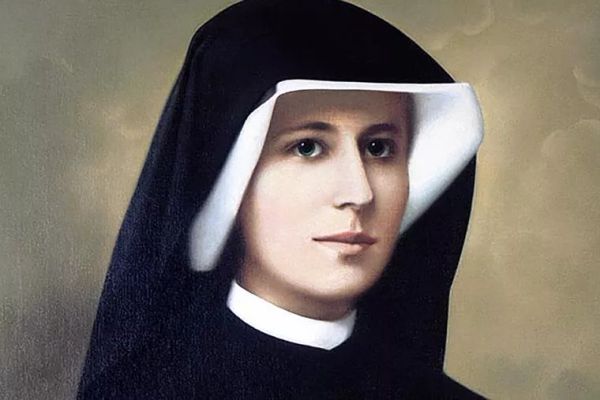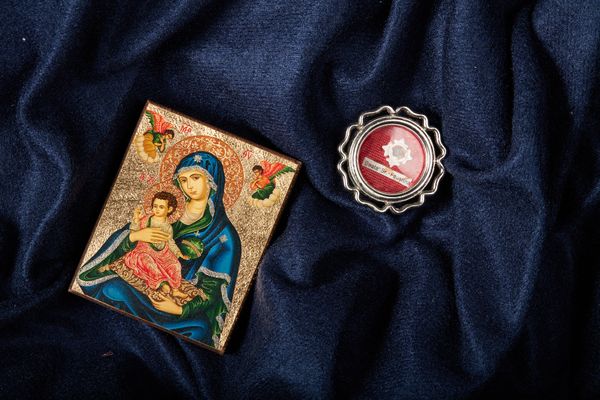Saint Maria Faustina Kowalska of the Blessed Sacrament was born as Helena Kowalska. She was the third of 10 children to a poor and religious family. Faustina first felt a calling to the religious life when she was just seven-years-old and attended the Exposition of the Blessed Sacrament. After finishing her schooling, Faustina wanted to immediately join a convent. However, her parents refused to let her. Instead, at 16-years-old, Faustina became a housekeeper to help her parents and support herself.
In 1924, Faustina experienced her first vision of Jesus. While at a dance with her sister, Natalia, Faustina saw a suffering Jesus and then went to a Cathedral. According to Faustina, Jesus instructed her to leave for Warsaw immediately and join a convent. Faustina packed her bags at once and departed the following morning. When she arrived in Warsaw, she entered Saint James Church in Warsaw, the first church she came across, and attended Mass.
While in Warsaw, Faustina approached many different convents, but was turned away every time. She was judged on her appearances and sometimes rejected for poverty. Finally, the mother superior for the Congregation of the Sisters of Our Lady of Mercy decided to take in Faustina on the condition that she could pay for her own religious habit. Working as a housekeeper, Faustina began to save her money and make deposits to the Convent.
On April 30, 1926, at 20-years-old, she finally received her habit and took the religious name of Sister Maria Faustina of the Blessed Sacrament and in 1928, she took her first religious vows as a nun. Over the next year, Faustina traveled convents as a cook. In May 1930 she arrived in Plock, Poland. Soon after, she began to show the first signs of her illness and was sent away to rest. Several months later, Faustina returned to the convent.
Visitation by Jesus
On February 22, 1931, Faustina was visited by Jesus, who presented himself as the "King of Divine Mercy" wearing a white garment with red and pale rays coming from his heart. She was asked to become the apostle and secretary of God's mercy, a model of how to be merciful to others, and an instrument for reemphasizing God's plan of mercy for the world.
In her diary, Faustina writes:
In the evening, when I was in my cell, I became aware of the Lord Jesus clothed in a white garment. One hand was raised in blessing, the other was touching the garment at the breast. From the opening of the garment at the breast there came forth two large rays, one red and the other pale. In silence I gazed intently at the Lord; my soul was overwhelmed with fear, but also with great joy. After a while Jesus said to me, 'paint an image according to the pattern you see, with the inscription: Jesus, I trust in You.'
Faustina also describes during that same message, Jesus explained he wanted the Divine Mercy image to be "solemnly blessed on the first Sunday after Easter; that Sunday is to be the Feast of Mercy." Faustina, not knowing how to paint, asked around her Plock convent for help but was denied. It wasn't until three years later, in 1934, that the first painting of the image was created by Eugene Kazimierowski.
In 1932, Faustina returned to Warsaw. On May 1, 1933 she took her final vows in Lagiewniki and became a perpetual sister of Our Lady of Mercy. After taking her vows, Faustina was transferred to Vilnius, where she met Father Michael Sopocko, the appointed confessor to the nuns. During her first confession with Sopocko, Faustina told him about her conversations with Jesus and his plan for her. Father Sopocko insisted she be evaluated by a psychiatrist. Faustina passed all the required tests and was determined sane, leading Sopocko to support her religious efforts.
The Novena of Devine Mercy
Sopocko encouraged her to start keeping a diary and to record all of her conversations with Jesus. Faustina told Sopocko about the Divine Mercy image and it was Sopocko who introduced her to Kazimierowski, the artist of the first Divine Mercy painting. According to Faustina's diary, on Good Friday, April 19, 1935, Jesus told her he wanted the Divine Mercy image publically honored. On April 26, 1935, Father Sopocko delivered the very first sermon on the Divine Mercy.
In September 1935, Faustina wrote about her vision of the Chaplet of Divine Mercy, used to obtain mercy, trust in Christ's mercy and to show mercy to others. During the following year, Faustina attempted to set up a new congregation for Divine Mercy, but was reminded that she was perpetually vowed to her current order and sent back to Warsaw. She reported Jesus said to her, "My Daughter, do whatever is within your power to spread devotion to My Divine Mercy, I will make up for what you lack."
Illness & Death
In 1936, Faustina fell ill again. She moved to the sanatorium in Pradnik, Krakow and continued to spend most of her time in prayer. In July 1937, the first holy cards with the Divine Mercy image were created and Faustina provided instructions for the Novena of Divine Mercy, which she reported was a message from Jesus. Throughout the rest of 1937, the Divine Mercy image continued to be promoted and grow in popularity.
Faustina's health significantly deteriorated by the end of 1937. Her visions intensified and she was said to be looking forward to the end of her life. On October 5, 1938, Faustina passed away. She was buried on October 7 and currently rests at the Basilica of Divine Mercy in Krakow, Poland.
Her entire life, in imitation of Christ's, was to be a sacrifice - a life lived for others. At the Divine Lord's request, she willingly offered her personal sufferings in union with Him to atone for the sins of others. In her daily life she was to become a doer of mercy, bringing joy and peace to others, and by writing about God's mercy, she was to encourage others to trust in Him and thus prepare the world for His coming again.
Her special devotion to Mary Immaculate and to the sacraments of Eucharist and Reconciliation gave her the strength to bear all her sufferings as an offering to God on behalf of the Church and those in special need, especially great sinners and the dying.
Credits:
Discriptions of saints lives and biographies have been excerpted, summarized, or compiled from
Franciscan Media,
CatholicSaints.Info,
Catholic Online, and
Wikipedia.

